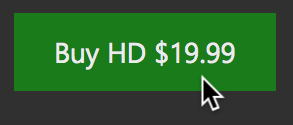App and media stores shouldn’t tell their customers that they’re “buying” digital content. Costumers aren’t in charge or nor do they’ve a say in how they can use what they’ve ”bought.” You aren’t “buying” digital content like apps, movies, and games. The stores shouldn’t continue calling it “selling“ when customers have no say in how they can use what they “buy.” I suggest making purchasing Digital Rights Managed (DRM) less appealing by changing the misleading “Buy” and “Purchase” buttons to something more accurate.

Today is the FSF’s 9th annual International Day Against DRM.
Any kind of app store or store for digital content should change their initiate-money-transaction-button label from “Buy” or “Purchase” to either “Rent” or “License”. The customer has no ownership over the purchased item/file when the companies keep the app, movie, audiobook, or whatever digital product you’ve just bought under crypt and key. After your alleged purchase, their servers will selectively for a time-limited and at their discretion unlock, your purchased digital product. If they terminate your account with them or simply shut down the service, you’re left with either vapor or a file filled with useless bits from your “purchase.” As long as they’re not turning control over the item you’ve bought from them to you; you’re not buying anything.

Xbox Video enticing customers to lease a movie with a ”Buy” label
Changing the clear, concise, and entirely misleading label into something more unclear and diffuse, but more accurate could hurt the digital content stores and their rights-holding partners monetarily. Requiring customers to think what the button says and what that means would be a game-changer for consumer awareness. Once revenue started to drop, the rights-holders would possibly be more willing to renegotiate their stand on DRM.
Dropping the DRM and allowing playback on any device of the customer’s choosing would be a huge win. Digital restrictions is mostly about retaining control. It’s partly also about planned obsolescence — as platforms die out customer’s must buy the same movie anew to watch it — and partially about platform lock-ins. As an iPhone or Android smartphone user; dropping your big monetary investment in the apps, movies, and books on your old platform to move over to Windows- or Ubuntu Phone sounds ludicrous. You’re locked in to a platform to continue accessing the content you’ve purchased on that platform. This is bad for consumer choice, innovation, and competition.

Some stores, like all of Apple’s App Stores and media stores, avoid the situation carefully by labeling the button with the cost of the transaction. Without making anything clear other than that you’ll give money to Apple. This is more honest in its unambiguity.
However, I don’t believe this is an okay way to go about it either. The default mindset and expectation of customers will still be that they’re making a purchase of something tangible.
I could be wrong, but I believe fighting the false promise that you “own” anything with DRM is the only way to change the status quo on DRM. If I could have one weapon in the fight against DRM from lawmakers — other than outright banning the anti-consumer practice entirely — it would be a requirement for these stores to provide a clear upfront explanation to customers that they’re buying nothing but promises….